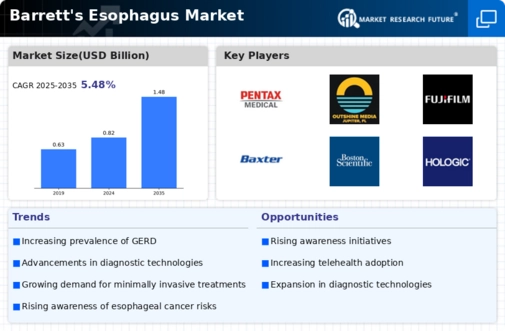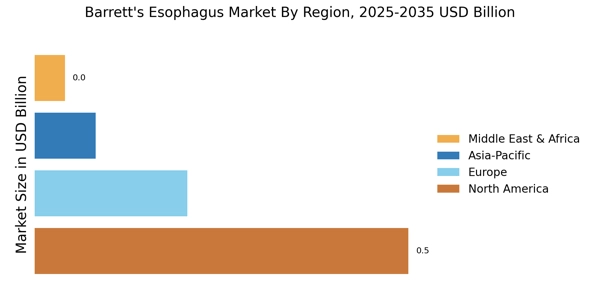Rising Healthcare Expenditure
The upward trend in healthcare expenditure is influencing the Barrett's Esophagus Market positively. As countries allocate more resources to healthcare, there is a corresponding increase in funding for gastrointestinal diseases, including Barrett's Esophagus. This financial support facilitates improved access to screening, diagnosis, and treatment options for patients. Reports indicate that healthcare spending is projected to grow at an annual rate of 5% over the next several years, which may enhance the availability of advanced therapies and technologies in the Barrett's Esophagus Market. Consequently, this increased investment is likely to drive market expansion and improve patient care.
Technological Innovations in Diagnostic Tools
Technological advancements in diagnostic tools are transforming the Barrett's Esophagus Market. Innovations such as high-definition endoscopy and advanced imaging techniques enable more accurate detection of Barrett's Esophagus at earlier stages. These technologies facilitate better visualization of the esophagus, allowing for precise identification of dysplastic changes. The market for these diagnostic tools is projected to expand, with estimates indicating a compound annual growth rate of over 10% in the coming years. As healthcare systems increasingly adopt these advanced diagnostic modalities, the overall efficiency and effectiveness of Barrett's Esophagus management are likely to improve, further stimulating market growth.
Growing Investment in Research and Development
Investment in research and development (R&D) is a critical driver for the Barrett's Esophagus Market. Pharmaceutical companies and research institutions are focusing on developing novel therapies and interventions for Barrett's Esophagus and its progression to esophageal cancer. This trend is underscored by the increasing number of clinical trials aimed at evaluating new treatment options, including targeted therapies and minimally invasive procedures. The financial commitment to R&D is expected to yield innovative solutions that address unmet medical needs, thereby enhancing patient outcomes and expanding the market. As new therapies emerge, the competitive landscape of the Barrett's Esophagus Market will likely evolve, presenting both challenges and opportunities.
Enhanced Patient Education and Awareness Programs
Enhanced patient education and awareness programs are emerging as a vital driver for the Barrett's Esophagus Market. As awareness of Barrett's Esophagus and its potential complications increases, patients are more likely to seek medical advice and undergo screening. Educational initiatives by healthcare organizations aim to inform the public about the risks associated with GERD and the importance of early detection. This growing awareness is expected to lead to higher screening rates and, subsequently, an increased demand for treatment options. The proactive approach to patient education is likely to foster a more informed patient population, thereby contributing to the overall growth of the Barrett's Esophagus Market.
Increasing Prevalence of Gastroesophageal Reflux Disease (GERD)
The rising incidence of gastroesophageal reflux disease (GERD) is a notable driver for the Barrett's Esophagus Market. GERD is a significant risk factor for Barrett's Esophagus, as chronic acid reflux can lead to changes in the esophageal lining. Recent estimates suggest that approximately 20% of the population experiences GERD symptoms, which correlates with a higher likelihood of developing Barrett's Esophagus. This increasing prevalence necessitates enhanced screening and treatment options, thereby propelling the Barrett's Esophagus Market forward. As healthcare providers become more vigilant in identifying at-risk patients, the demand for diagnostic and therapeutic solutions is expected to rise, creating opportunities for market growth.


















Leave a Comment